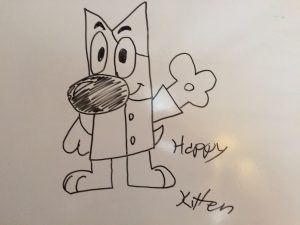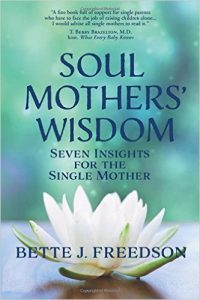with Bette Freedson
Editor’s Note: “Kitten” has given permission to share her story and her drawing.
What might happen if you envisioned a second version of yourself, a personal avatar that embodied knowledge for attaining your goals, for guiding your life or for improving your tennis game?
If you mentally and somatically embodied your avatar’s strengths, feeling the knowing and knowing the feelings from inside out, imagine the empowerment of accessing resources of an alternately equipped Self.
Timothy’s Gallwey’s “The Inner Game of Tennis” suggests that the body and the unconscious mind can absorb positive images after which a type of “second self” can express what the body now innately knows, how to play tennis “in the flow” with effortless concentration.
In the movie Avatar, the disabled main character, Jack Sully, has his consciousness transferred into his avatar, an alien body made whole and strong through the help of a healing tree. Avatar stunningly depicts the healing force of our connectedness to nature, to others and within the neurobiology of the Self. Further, it gently suggests that connection with other aspects of our own nature might give embodied empowerment to new strengths.
Affectively labile, emotionally fragile and introverted at age fourteen, Kitten was prone to severe anxiety with suicidal ideation. Now, a college freshman, she is more functional under stress and less labile. She is also an avid cartoonist and follower of Japanese-style video games.
Kitten’s goal is to create video game characters with stories in the Japanese style, which, she explained, unlike American stock-plot super-heroes, are multi-dimensional. Early in treatment, it became evident that Kitten herself seemed one dimensional, as many aspects of her Self were fragmented and dissociated. Both painful and positive emotional moods and states were unrecognizable for Kitten—with one exception.
When deeply in-the-flow of drawing, a type of “second self,” cut off from Kitten’s awareness and drew cat-like characters with facial and postural affect that expressed emotions that consciously Kitten knew nothing about. In the spirit of an Ericksonian approach, it occurred to me that these characters might be of help.
Our Innate Healing Potential
That we have innate healing potential available for the betterment of Self and others has been a fulcrum of my work and the fascination of my life since Charles Ashley, head of the school where I taught English explained the concept of “self-fulfilling prophecy.” Understanding that positive beliefs potentiate success, Charlie encouraged his teachers to think of capacity and competency instead of failure. He assured us that this thinking would be manifested in our actions, thereby conveying esteem and success to our students.
As other mentors entered my life, I began to grasp that Charlie’s views had soul wisdom and brain science at their core. After my divorce, renowned psychic Ramona Garcia enlightened me about positive thinking and the power of intention. Ramona taught me how to meditate and how to use positive self-talk to manage stress and access the resilience I needed to cope with adversity.
Today, Dr. Jeffrey Zeig, Director of the Milton H. Erickson Foundation, has been helping me develop an Ericksonian approach that integrates clinical skills and belief in the power of the unconscious mind for the purpose of orienting clients toward access of dormant inner resources.
Envisioning and embodying aspects of Self that have power to relieve stress, build resilience, access insight and even change our brains resonates with both soul wisdom and brain science. While we know of no specific healing tree, spiritual masters teach that we are energetically connected to nature, and brain science teaches about the neural connections creating somatic intelligence within ourselves.
In essence, we know what mystics, healers and shamans have known—how we think, behave and interact can have profound effects on our stress levels, our mind/body/soul sense of Self, and even on our brains.
With this information in mind, I asked Kitten if she would draw characters with facial expressions and body postures based on stories she made up. She would then label their feelings. Excited about the project, Kitten began to identify and label her characters’ emotions. Slowly, she was able to identify similar feelings in herself, and begin the journey of becoming multi-dimensional. Currently, Kitten is creating a multi-layered story and a complex secret character.
 While I am not permitted to reveal everything about this new character, I am allowed to tell you that Kitten says she is making it “like I want to be.” I also have permission to describe the session during which, after relaxing into a light trance, Kitten happily discussed her super-woman, no-name “main character”.
While I am not permitted to reveal everything about this new character, I am allowed to tell you that Kitten says she is making it “like I want to be.” I also have permission to describe the session during which, after relaxing into a light trance, Kitten happily discussed her super-woman, no-name “main character”.
Our session:
“After an alien spaceship crashes into her yard, she discovers a robo-dog and alien technology. She explores the spaceship and finds gloves that give her special powers. She finds power boots that can make her jump higher. Her mission is Justice, and I am creating her like I want to be. She does good work. She has a lot of friends and she is brave. I’m not brave.”
“If you are creating your main character to be like you want to be,” I ask, “Would it not be possible that you are already becoming a little more like her?
“I dunno,” Kitten replies.
“Four years ago you were not as organized or confident as a student as you are now. Now, you are doing good work.
If you had cried in a session back then, you might have bolted. Now you are staying. Could we not say that you might be feeling a little braver than you think?”
With tears at the edges of her eyes, Kitten replies, “I dunno.” Then, after a thoughtful pause, “But… I didn’t blow up!”
“Kitten,” I ask, smiling. “Remember the feeling cards?”
Smiling back, she says. “Yup! The only thing is… I don’t know where they are.”
“Could they be right where you need them?” I gently ask.
With her hand at her heart, Kitten replies. “I think they’ve gone in here.”
“And,” I venture, “Now you can know the feelings for your super-hero secret character, and now they are no longer a secret for you.”
Bette J. Freedson, LCSW is a clinical social worker, certified group psychotherapist, and the author of Soul Mothers’ Wisdom: Seven Insights for the Single Mother. Bette’s specialties include stress management, parenting issues, recovery from trauma and the development of intuitive insight. She maintains a private practice in southern Maine with her husband, Ray Amidon, LMFT.








